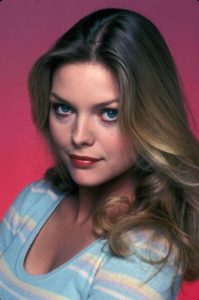
True confession time: I have always had an enormous crush on Michelle Pfeiffer. Sure, a lot of that has to do with physical attractiveness- she is one of the most beautiful people alive. But so much of it stems from her presence on-screen, the way she brings- not a vulnerability per se, but more like a raw, exposed nerve to her performances. It was these qualities that were apparent, even when she was first slowly breaking into features in the early 1980’s (I haven’t seen- or in no way recall at least- her television work on Enos, Fantasy Island or B.A.D. Cats, but let’s imagine it still shows that unmistakable spark of someone about to hit it big).
Her golden years, in the mid-80’s to early 90’s, are marked by a willingness to work with true auteurs and to take on challenging roles. This is the period marked by her Catwoman in Tim Burton’s Batman Returns, and her mafia widow in Jonathan Demme’s Married to the Mob. She worked with Stephen Frears in Dangerous Liasons, George Miller in The Witches of Eastwick, Martin Scorsese in The Age of Innocence and Brian De Palma in Scarface. This is when she voiced a character on The Simpsons for goodness sake! All of her most memorable roles stem from this period. One doesn’t think of Pfeiffer without immediately picturing her slinking across a piano in a red dress, or dressed in a rubber catsuit. It was these performances that earned her accolades (her three Academy Awards nominations all stem from this period) and shot her to super-stardom.
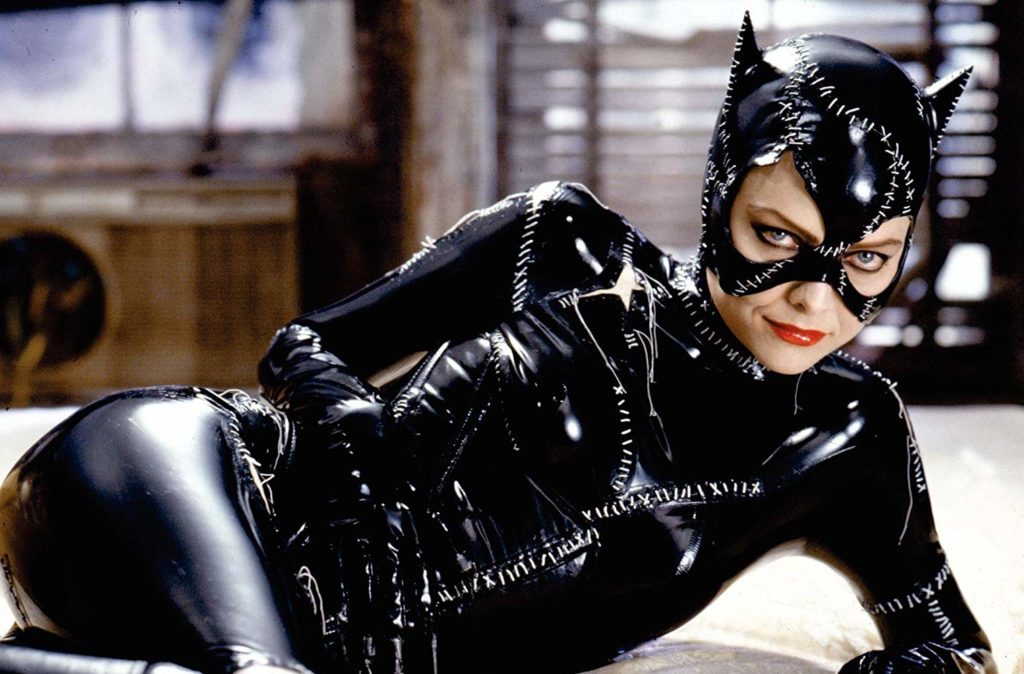
Beginning in the mid-90’s, Pfeiffer has become one of the biggest stars in Hollywood and is a top box-office draw. The problem for many is that once they hit this level of popularity, they work very hard not to lose it. As a consequence, the roles actors tend to take are super-safe and, dare I say, boring. Her career at this point is defined by mainstream Hollywood fare- romances like One Fine Day, and Up Close and Personal, or uplifting and inspirational pap like Dangerous Minds and I Am Sam. Many of the films from this period aren’t bad (though there are some real clunkers- looking at you The Story of Us and I Am Sam), and they’re all hits, but none of them provide the same naked energy her earlier roles gave us.
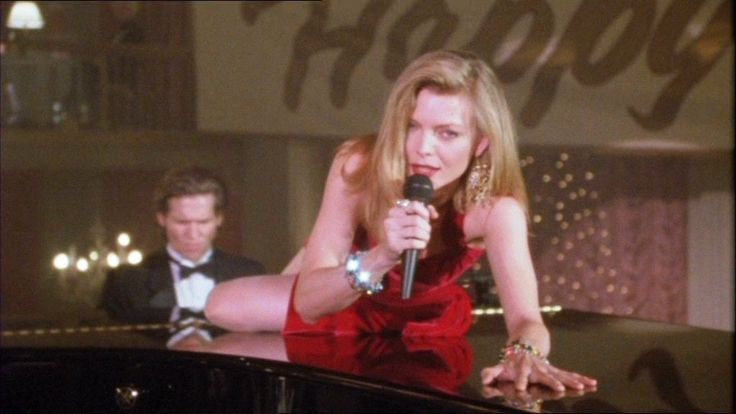
Lately, however, there seems to be a return to taking risks. She never really went away- Pfeiffer has worked steadily throughout the years- it’s just that she hasn’t really taken any roles that commanded our attention until she shows up as Bernie Madoff’s wife in HBO’s The Wizard of Lies, directed by Barry Levinson. She has since had supporting roles in such diverse projects as Kenneth Branagh’s Murder on the Orient Express, Darren Aronofsky Mother! and Ant-Man and the Wasp. This is probably as much a result of reaching ‘a certain age’ and finding many mainstream Hollywood roles closed off to her. But at the same time, it’s thrilling to see her pushing at those boundaries again.
– Jeffrey Knight
The Age of Innocence
1993, Columbia Pictures Corporation, dir. Martin Scorsese
by Erik Yates

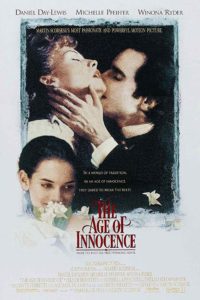
Michelle Pfeiffer has always been a guilty pleasure for me growing up. She was beautiful of course, but her roles were varied, complex, and she always seemed able to command the screen with the smallest look. This has of course continued into the present with her more recent roles including joining Marvel’s MCU in Ant-Man and the Wasp, to the frantic Biblical-horror film of Darren Aronofsky’s Mother!. One film that had eluded me, which I admit to here, is Martin Scorsese’s adaptation of the novel, The Age of Innocence.
The film’s three leads are a powerhouse trio of the time, and even today, with Daniel Day-Lewis, Michelle Pfeiffer, and Winona Ryder. The film focuses on the repressed angst of a man named Newland Archer (Day-Lewis) who is engaged to be married to May Welland (Ryder) as a part of 1870’s New York’s elite social class. While he loves his betrothed, he is taken by the appearance of May’s scandalized cousin, the Countess Ellen Olenska (Pfeiffer) who has left her Polish husband in Europe and returned to the United States. The Age of Innocence is a film that most will raise an eyebrow over when they find out it is a Scorsese film as he is not usually known for costume pieces. Once you see it, however, you will realize that what Scorsese once told Roger Ebert is true in that it is still filled with his trademark violence, it is just done behind the eyes and under the pretense of the polite society. The repressed rage Archer feels that he cannot break off his engagement and be with Mrs. Olenska because of the expectations that comes with his privileged status is truly felt in every scene.
Anchoring it all though is Michelle Pfeiffer. She must simultaneous present herself as a vulnerable debutant who has fallen from grace among her peers for her scandalous impending divorce, as well as demonstrate her true feelings of attraction for her cousin’s fiancé while repressing these feelings so as to do right by both her family and society. It is here that Michelle Pfeiffer’s ability to command the screen with complete subtlety is on full display. While Daniel Day-Lewis is the one being visibly tossed emotionally as a man caught between expectations and desire, it is Pfeiffer who must fully embody these same emotions and demonstrate the strength that Day-Lewis’ Archer can’t seem to summon. Her ability to endure her own suffering for the greater good makes the final scene all the more heartbreaking when years later circumstances change, and Countess Olenska is free from her suffering but Mr. Archer is not. Michelle Pfeiffer was a fantastic fit with Scorsese’s period piece and The Age of Innocence is no longer a hole for me in her filmography.
Scarface
1983, Universal Pictures, dir. Brian De Palma
by Sharon Autenrieth


I missed the original run of Scarface in 1983 and only came to know of the movie after it had become entangled with rap music and after a certain climactic line had become a pop culture catch phrase. That made it a challenge to view the movie without seeing its excesses – of violence, drugs, sex, and interior design – as camp. It’s hard to take seriously now, all of those Italian actors laying on the thick Cuban accents to persuade audiences. C’mon, mang, I’m not buying it. Hard not to be put off by the incestuous subtext between Tony Montana (Al Pacino) and his sister, Gina (Mary Elizabeth Mastrantonio). Hard not to laugh just a little at Tony, deep in his Is that all there is? funk, sitting behind a mountain of cocaine, his nose covered in powder. And the violence! Good grief! We’re still in the first act when someone is losing limbs to a chainsaw and the room is dripping in blood. Scarface tells the story of a Cuban criminal, newly arrived in Miami as part of the Mariel boatlift, who rises rapidly from a mob thug to a drug kingpin. Al Pacino’s performance is full of bravado, but he loses some of the animal-like intensity that Paul Muni brought to the 1932 original – and his death scene is either spectacularly unrealistic or a tribute to the miraculous powers of coke. How could anyone take that many bullets and stay on their feet, taunting their enemies? Who is this guy? Jason Voorhees?
But there’s nothing laughable or campy about Michelle Pfeiffer’s performance. With the unwieldy name Elvira Hancock, she is what used to be called a moll, the mistress of a local drug lord, Frank, played by Robert Logia. Elvira becomes Tony Montana’s first real conquest in this land of opportunity. She is an icy blonde; beautiful, brittle, and rail thin from living on cocaine and little else. Her emotional remoteness is smartly symbolized by her first dance with Tony at a disco. She dances with her back to him, trying to avoid conversation as Tony tries to impress her. He wins her over eventually…or she resigns herself to being with him when Frank is taken out of the equation. Marriage to Tony improves neither her disposition nor her drug habit, and the two of them soon spend their days bickering in their garish, gilded mansion.
Elvira disappears from Scarface before Tony’s violent ending, but not before Michelle Pfeiffer is able to deliver a drink to his face along with a scathing rebuke in the middle of an upscale restaurant. It reminded me of a scene from another, much older gangster film: 1931’s The Public Enemy. Those pre-code gangster films contained a lot of gun violence, but nothing shocked or upset audiences more than seeing James Cagney, as gangster Tom Powers, shove a half grapefruit in his girlfriend’s face. When Elvira threw the drink at Tony and told him what she really thought of him, it seemed like payback for every moll who was treated with contempt in those old movies. Elvira may not have lived with much self respect, but at least she knew enough to leave before Tony’s final act.
Dangerous Minds
1995, Hollywood Pictures, dir. John N. Smith
by Robert Hornak


Padding in to the thump of Coolio’s Gangsta’s Paradise, Pfeiffer is real-life Louanne Johnson, a former Marine in mid-divorce looking for reinvention who gets a bit of one when she steps into a hail of cliches so ripe they threaten to kill her of scurvy. Watching Johnson take on the worst class at at the worst Palo Alto high school and shape them up with a mix of tough love and furrow-browed understanding makes one, first cringe, then think of at least a dozen other movies just like it going back to the ’50s. But for my money, if one must see it, it’d make a better double feature with Brubaker, the Robert Redford penitentieary pic with him as the too-pretty whitebread warden trying to cinch up some tough hombres with an earnest flick of his good intentions. At no point in either film is it ever believable that stern blue eyes are all you need turn a ragtag group of misfits around – maybe let’s call this the “cheekbone saviors to the rescue” subgenre.
The movie’s doubt about its own premise rides the constant crashing wave of synth music and pandering R&B that pumps up the jam every time a kid makes even the remotest shoulder shrug toward Dylan Thomas. I especially love the amusement park detour as reward for reading poems, an adventure that plays like connect-the-dot Cuckoo’s Nest. But none of this diminishes Pfeiffer’s performance, which may be the only thing keeping the entire Jenga tower of predictability from collapsing, or those of most of the cast of kids, who each fill out screenwriter Ronald Bass’s old-white-guy conceptions of the lower social orders with a verve that’s nowhere on the page.
But I need a signed permission slip from your parents before I’ll believe all it takes is an ad hoc karate lesson to turn this gang of misfits into your panting acolytes. I think I misread the pop-culture verdict on this one: I thought it’d been deemed iffy but acceptable on a tough-love hall pass. Now that I’ve seen it I realize its only lasting imprint of cultural import may be Weird Al’s Amish Paradise. (So I can’t really complain.)
One Fine Day
1996, Twentieth Century Fox, dir. Michael Hoffman
by Taylor Blake
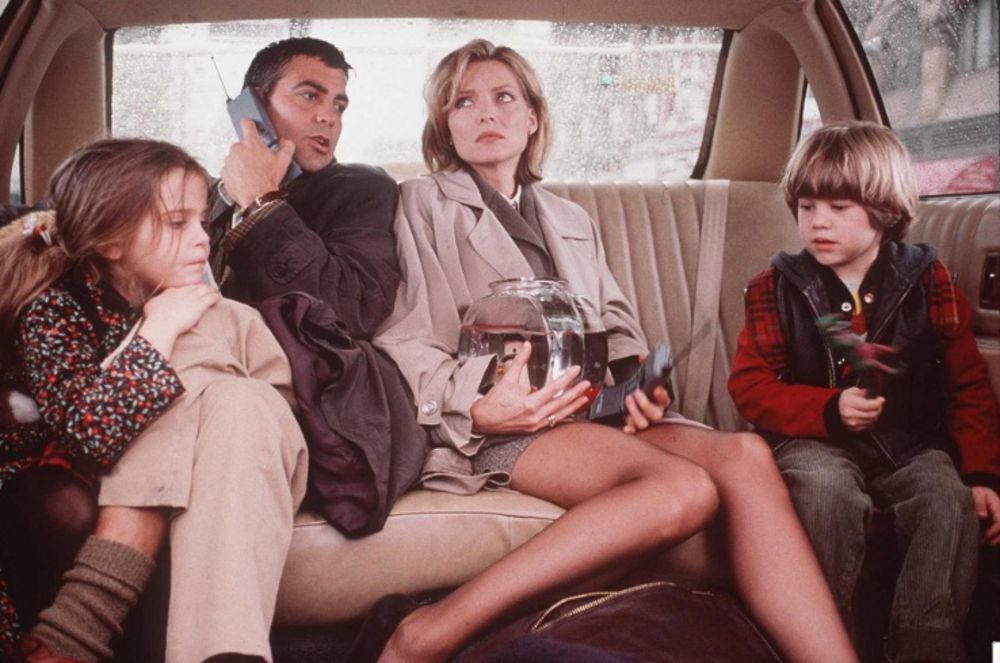

Good news, everybody: We’re due for another Romantic Comedy Renaissance. About every 30 years, Hollywood decides it loves rom coms, starting all the way back with the screwball classics of the 1930s with Katharine Hepburn, Cary Grant, and Irene Dunn. In the ‘60s, we saw both fluffy romances for Doris Day and Rock Hudson and more grown-up comedies like Breakfast at Tiffany’s. The last rom-com-assiance of the ‘90s came courtesy of Nora Ephron, Nancy Meyers, and Garry Marshall.
The bad news: When there’s an abundance of similar movies made in a short burst, even good ones can get lost. Such is the case with 1996’s One Fine Day, a predictable but charming movie starring Michelle Pfeiffer and George Clooney no one talks about today. I couldn’t find anywhere to stream it (thank goodness for the library!), but I wouldn’t mind if Netflix let the collective we remember how enjoyable it is.
Clooney and Pfeiffer play single parents of adorable children (Mae Whitman, Alex D. Linz) who are classmates in grade school. When the kids miss their field trip as both parents are fighting deadlines at work, a chaotic day begins made up mix-ups, messes, and plenty of flirtatious banter. Clooney is the Cary-Grant-heir-apparent scene-stealer, but Pfeiffer has the more difficult job. She transforms from archetypal ice woman to vulnerable heart-stealer, a role that could have been as unforgiving as it could have been cliché. While she’s not known for her comedies as much as her dramas, she makes both the situational and light physical humor work. It doesn’t hurt that the pair makes their chemistry look easy—both actors are at peak heartthrob status, which is another reason I’m baffled that this has become a forgotten film.
If pattern follows, Hollywood is going to remember how to make ‘em like they used to in the 2020s. (Here’s hoping Crazy Rich Asians is a sign of good things to come!) So go ahead and twist my arm, Hollywood—I’ll watch your next round of romantic comedies when they arrive, and I’ll be re-watching ones like One Fine Day until then.
The Story of Us
1999, Castle Rock Entertainment, dir. Rob Reiner
by Jim Tudor
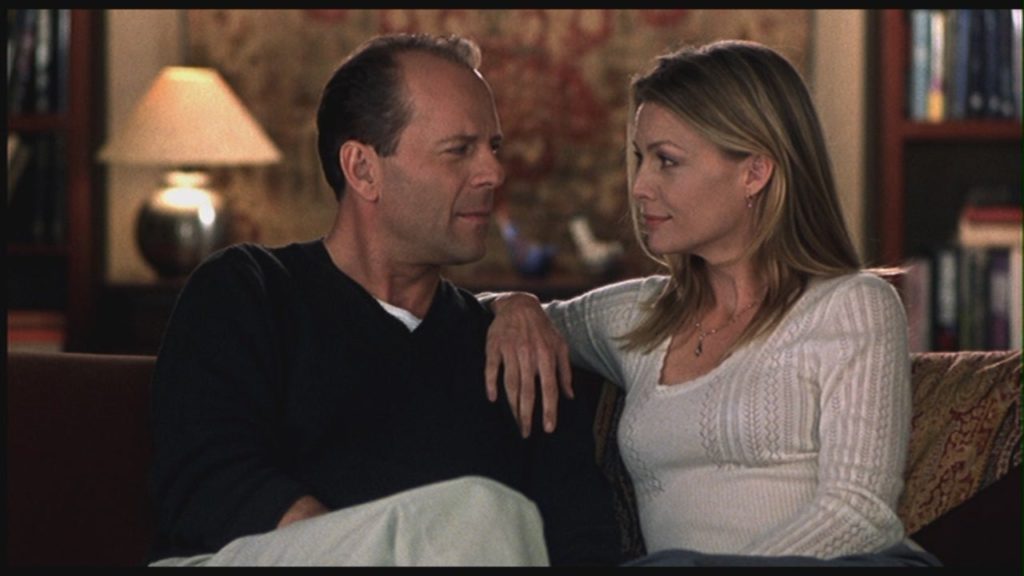
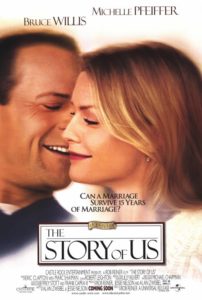
The story of The Story of Us might go something like this: Somebody somewhere decides that the world needs a straightforward depiction of the way an ordinary marriage can disintegrate over time. Kind of an American Scenes From a Marriage. 1990s marquee superstars Bruce Willis, Michelle Pfeiffer and director Rob Reiner all take an interest, perhaps with just a glint of Oscar hope. Reiner, still warm from his 1980s hot streak, is able to wrangle whomever and whatever he needs. DP Michael Chapman shoots, rock star Eric Clapton does the music, and the supporting cast is chock full of one-scene performances from acting notables Julie Hagerty, Betty White, Tom Poston, Red Buttons, and others.
Slowly but surely, like the central marriage being depicted, The Story of Us erodes internally. Maybe someone said, “You know, this film of two ordinary people breaking up is awfully depressing. Maybe we punch it up, you know? Make it more of a Woody Allen screenplay than an Ingmar Bergman one. The funny parts will help make it all digestible. These people should be more like us: Well off! Big houses, fancy restaurants, nice clothes… it’ll be the life that any crossword puzzle writer would have! And when they decide to try to reset their relationship, how about a trip to Venice, Italy? It’s what anyone would do!” Before long, this supposed “story of us” is now a “story of them”, throwing just enough “relatable” bits at our heads to keep vital plot points semi-recognizable.
But, what’s most recognizable is the sitcom overgrowth that‘s smothered whatever respectable roots the project may’ve ever had. Reiner, a performing veteran of the Norman Lear TV comedy revolution, attempts to emulate, or at least reflect, the bold “normal people in the real world, with jokes” formula of All in the Family and its spinoffs. But Willis’s charm is forced, Pfeiffer isn’t interested in being funny (and appears uncomfortable when she’s expected to be), and Reiner himself, playing the affable best buddy, is a barrage of cringe-worthy bad schtick. When in doubt, he talks about his ass. And doubt is rampant in The Story of Us.
The part Michelle Pfeiffer plays could’ve gone to any number of actresses, and yielded the same results. It isn’t that Pfeiffer falls short in the role do much as the roll falls short of her. Even as Bruce Willis fights valiantly to find a pulse in his part, Pfeiffer opts to function in the opposite direction, downplaying any trace of work. Hence, she quietly fades into the woodwork, even as we (in theory) spend the film hoping she and her husband can somehow make it. That we’re able to feel that way at all is the subtlest of testaments to her approach in this very flawed film.
Married To The Mob
1988, Orion Pictures, dir. Jonathan Demme
by Jeffrey Knight
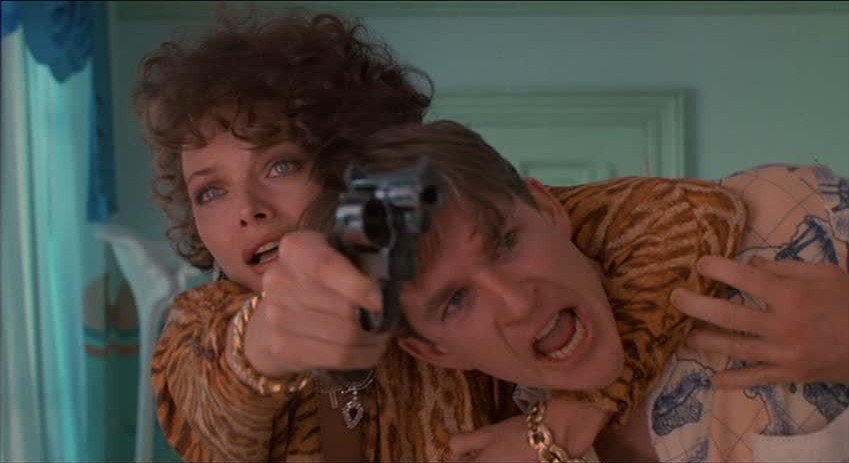
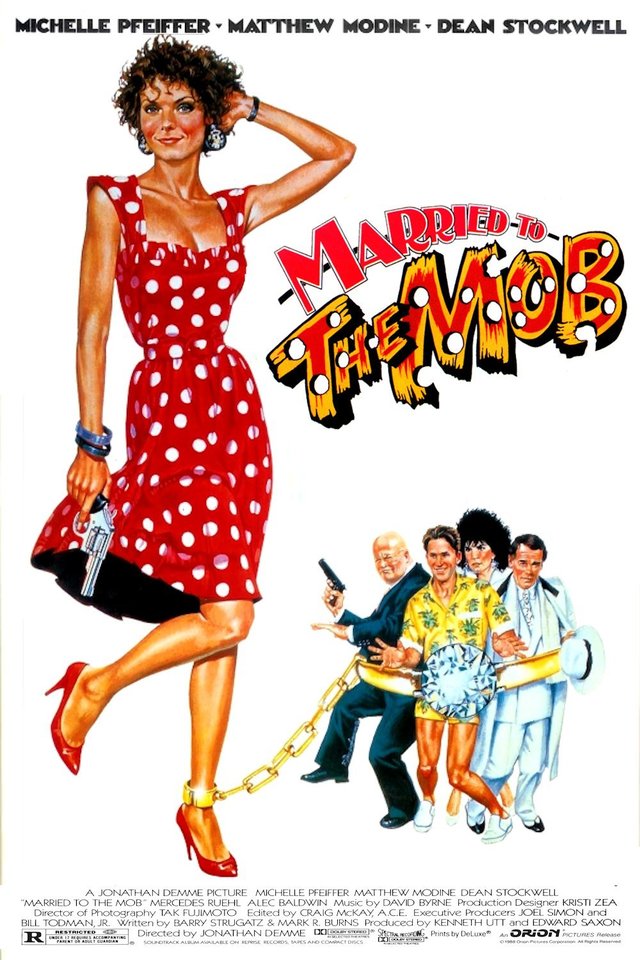
Married to the Mob is an unessential Jonathan Demme film. It’s clearly work by a director with a certain style- it shows typical Demme hallmarks such as actors performing directly into the camera, is shot by his usual cinematographer Tak Fujimoto, and many of Demme’s favorite character actors like Paul Lazar, Chris Isaak, Tracey Walter and Charles Napier appear in bit roles. But the film lacks the chaotic energy his earlier Something Wild has, even as it hits many of the same themes. Watching it is an amusing way to spend time, but for all but the most completist of Demme’s fans, it’s perfectly skippable.
For fans of Michelle Pfeiffer, however, Married to the Mob is essential viewing. Her role as Angela De Marco is her first time headlining a movie and it’s her performance alone that earns the film any amount of goodwill that it has. Pfeiffer brings an ‘A’ game to this ‘C’-list material for her part (compare her performance to whatever it is Matthew Modine is doing). Pfeiffer exhibits all of the qualities that make her such a compelling actor: there’s an inner ferocity that’s barely being held in check.
In Married to the Mob, Pfeiffer’s character is married to ‘Cucumber’ Frank De Marco (played by Alec Baldwin). Angela confesses that she is done with the whole gangster lifestyle, and wants a more honest life for her and her son. Frank dismisses her threats of divorce as a joke, but soon winds up dead because he’s been seeing someone on the side- the same someone local mob boss Tony ‘The Tiger’ Russo (Dean Stockwell) has been seeing. Freed from her husband and the mob (or so she thinks), Angela gives away all her belongings and tries to start a new life with her son in lower Manhattan.
The FBI, however, believes she might have had something to do with her husband’s murder, and they assign a pair of special agents, played by Matthew Modine and Oliver Platt to place her under surveillance. Modine’s character, a cartoonish goofball named Mike Downey, accidentally ‘meet-cutes’ Angela, and before too long the two are dating each other. Their relationship will be sorely tested when the Feds begin to put pressure on Angela to deliver solid evidence of Russo’s involvement in Frank’s death.
Married to the Mob has a respectable body count, as befits a story about murderous gangsters, but it really is just a silly little affair. The cast, all very much not Italian, do their best goombah impersonations. Nobody takes it very seriously and everyone is having a good time. Pfeiffer’s presence, however, elevates the slight material. It’s probably fair to say that without her, Married to the Mob would have been completely forgettable- even for Jonathan Demme enthusiasts. No one watching it, however, will easily forget Pfeiffer as Angela De Marco. It’s her breakout performance and the start to a rocket-powered ride to stardom. She has more exciting roles to come in the near future, but her star-making turn here, as a mafioso’s widow, made it all possible.

